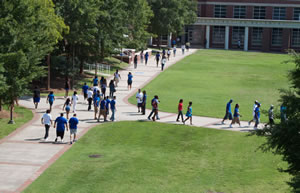Dressing Up in Your ID Badge
- By Michael Fickes
- 06/01/14

PHOTOS © JOHN S. CROSS, TSU MEDIA RELATIONS
On March 1 of this year, Tennessee State University (TSU) in Nashville went live with a series of changes in its security policies and a system upgrade. The upgrade was a move to smart cards, and the policy change required everyone — students, faculty, staff, visitors and contractors — to wear and display the smart card ID badge.
The changes arose from incidents that had occurred on and near the campus — vandalism, break-ins and troubling events involving guns.
Back in late January, around 9 P.M. on a Tuesday night, students and faculty milling around Kean Hall and Boyd Hall on TSU’s main campus heard a gunshot just off campus. The local television station WKRN-TV reported that two people had been fighting about a gambling debt. When others jumped into the fray, a man pulled a gun and fired, hitting another man in the leg. TSU issued an emergency message urging everyone on campus to take shelter.
No member of the TSU community was involved in the shooting.
A couple of weeks later, a man not connected to the university got into an altercation with students. Campus police responded and calmed things down. Later that evening, a student involved in the altercation told a patrolling officer that the man had returned to campus. The officer questioned the man, and realized he had a gun. Thinking quickly, the officer put his hand over the gun at an angle that prevented it from being fired and subdued the man.
In the wake of these incidents — involving people not connected to the university — students, faculty and staff approached the administration and requested tighter security, says Henry Vaughn, manager of the ID and Access Control Center at TSU. The Center is a new organization, and part of the university’s response to the students’ request. Vaughn is slated to move up to the post of director of the Center as it begins to roll out more services.
“The university has a history of issues with the neighborhood surrounding the campus,” says Vaughn. “In response to the requests for changes, we adopted a strict policy — if you’re on campus, we want to know who you are.
“At many schools, you might be asked to show your ID. That was our practice. But now, to ensure that we know who is on campus, our policy requires everyone to wear an ID badge. The policy covers faculty, staff, visitors, students, contractors — anyone that has business on campus.”

A SENSE OF BELONGING. After a rash of break-ins and vandalisms attributed to people not associated with the university, as of March 1, all Tennessee State University students, faculty, staff and administrators will be required to wear and display identification badges while on campus or attending campus events. TSU officials say the new policy is intended to readily distinguish university personnel and students from visitors and unwelcomed guests, with the ultimate goal of increasing campus security, streamlining safety practices and increasing customer service.
The policy went into effect on March 1 and included the introduction of new smart card identification badges that replaced the mag-stripe cards that had been in use for years. Vaughn’s Center prints the new cards.
“We used to have key fobs for access and a mag-stripe card for other applications — two separate pieces,” continues Vaughn. “Now we have a single piece, an HID card with iClass proximity technology.”
The TSU iClass cards also have a magstripe so that the bookstore, dining halls and other campus services won’t need to convert immediately to new readers.
Pushback
The new policy requiring everyone on campus to wear an ID badge has produced some pushback. “Compliance by students was pretty low at first,” Vaughn says. “Everyone found the change difficult. I think we’ll see better results when the new freshman class arrives. They won’t have any experience not wearing the badge. So it won’t be a change for them.”
In addition, some students have complained that the new cards and readers enable the university to track their every movement. The local media has picked the story up and repeated it.
For instance, one article said: “Officials at Tennessee State University have implemented new rules to force students to carry ID badges that will allow them to be tracked…”
Another called the cards “traceable identification badges.”
These reports are wrong. In terms of tracking, these cards are no different from the cards carried by students at hundreds of other campuses across the country.
“We’re not tracking every move,” Vaughn says. “I’ve read the articles that say we’re tracking people, but that isn’t part of the system’s capabilities. All we’re doing is tightening polices that were already on the books and enforcing them.”
It is true that when a student or a member of the faculty or staff cards into an access controlled building, the system records a number associated with that person. “Those records make up an audit trail,” says Paul Timm, president of Lemont, IL-based RETA Security, Inc. “No one uses access control audit trails for real-time tracking. Audit trails are used during investigations.”
Suppose, for instance, an assault occurs in an access-controlled science lab late at night. If the individual that was attacked couldn’t name or identify the attacker, the audit trail would provide the names of the people who carded into the building during the hours leading up to the assault.
Audit trails also help to administer the system. For example, an audit trail may explain why lines are forming at certain doors at certain times of day — too many people for just one door. Installing another reader at another door can solve that problem. In such a case, no one would bother looking at names. It’s the numbers that would matter.
If there is a fire, an audit trail can tell the police and fire responders who carded into the building and might still be in there. “We would like to have an accurate list of who is in a building if there is a fire or some kind of incident,” Vaughn says. “But we haven’t fleshed that out yet. We don’t want to make people card out of buildings.
“There are systems that use RFID towers to monitor everyone moving in and out of a building, but we don’t want to do that either.”
A similar, but slower, investigative process would apply to a manually keyed building. If investigators want to know who is in a key-locked building, they would begin with the list of people issued keys to the building.
An electronic access control system simply automates that work and winnows the list of names down to those that entered at the time in question.
Other Uses
Contactless smart cards have many other applications as well. For instance, TSU is beta testing the use of the access control system to handle the administrative task of checking classroom attendance. “This system will have panel readers about the size of two tablets,” Vaughn says. “The will be able to read cards from a distance of about three feet. So if a student’s hands are full and he or she can’t pull out the access card, the reader can still record the individual’s attendance.”
Contactless smart card applications beyond access control include time stamping for hourly workers, biometric authentication, secure portable medical recordkeeping, prepaid telephone accounts, logical network access, mass transit payment, retail debit accounts, driver’s licenses and much more.
In short, a college or university can start small and grow into as many contactless smart card applications as are practical for the campus.
This article originally appeared in the issue of .